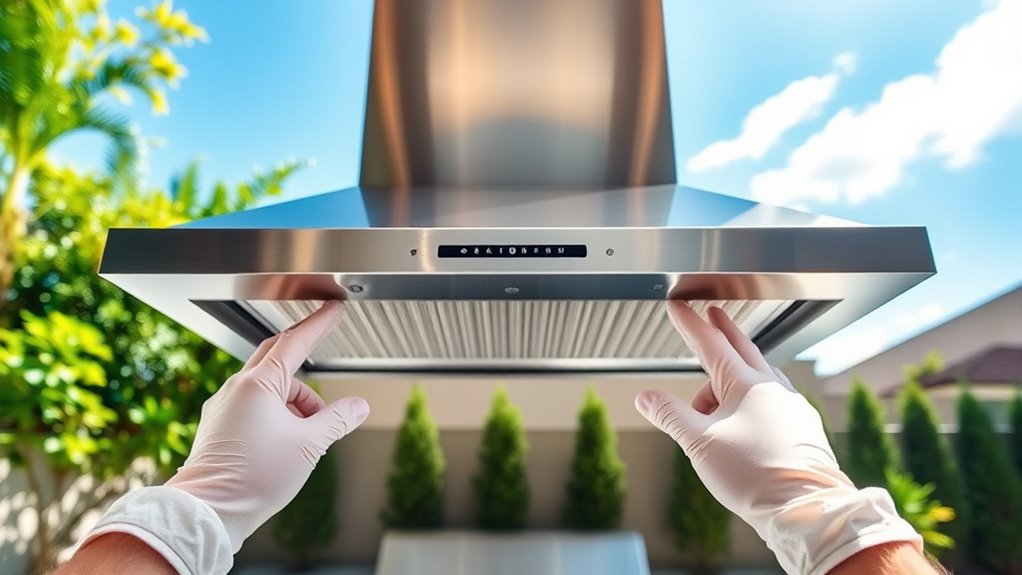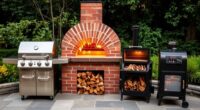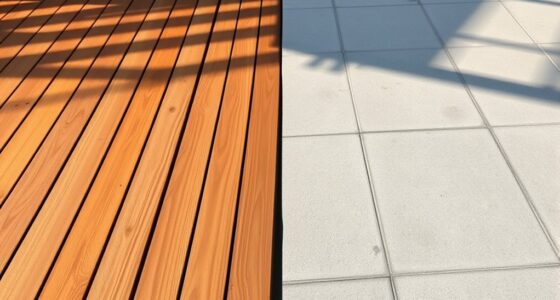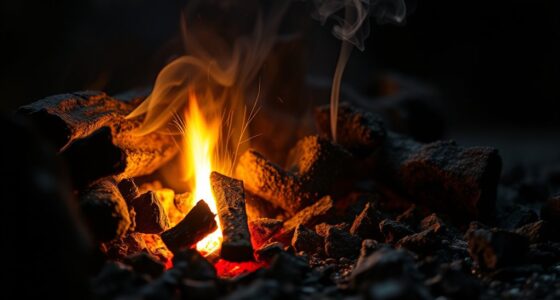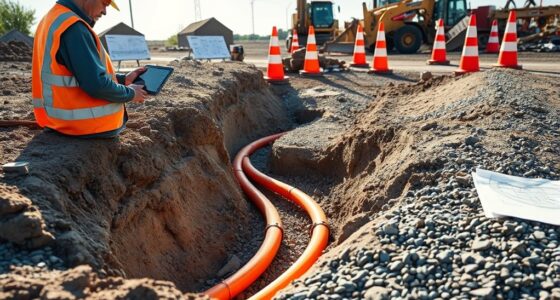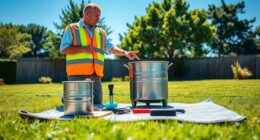To quickly boost outdoor vent hood safety and efficiency, start by turning off the power before cleaning or maintenance. Regularly check and replace filters, clean fan blades, and remove grease buildup to prevent fires and airflow issues. Make certain your vent is installed at the correct height and seal duct connections tightly. Keep a fire extinguisher nearby and test smoke alarms often. Keep these tips in mind, and you’ll learn even more ways to keep your outdoor cooking safe and smooth.
Key Takeaways
- Turn off power and wear gloves before cleaning or maintaining the vent hood outdoors.
- Regularly clean filters, fan blades, and remove grease buildup to ensure proper airflow.
- Install the vent hood 24-30 inches above the cooktop for optimal safety and performance.
- Keep a fire extinguisher nearby and test smoke alarms regularly during outdoor cooking activities.
- Inspect wiring and connections for damage, and contact professionals for complex repairs or electrical issues.
Understanding Your Outdoor Vent Hood System

Understanding your outdoor vent hood system is essential for maintaining proper airflow and ensuring your kitchen stays smoke- and odor-free. When you know how your system works, you can optimize airflow effectively, preventing buildup of smoke or grease. Regularly checking and adjusting your vent hood’s components helps achieve airflow optimization, making sure fumes exit efficiently. Don’t forget about filter replacement; dirty filters restrict airflow and reduce the system’s efficiency. Replacing filters as recommended keeps the exhaust system working smoothly and maintains good indoor air quality. Properly designed systems incorporate commercial-grade components that enhance durability and performance. By understanding the basics of your outdoor vent hood, you can troubleshoot issues early, improve performance, and extend its lifespan. Keep an eye on airflow and filters, and your outdoor vent hood will serve you well over time.
Regular Cleaning and Maintenance Practices
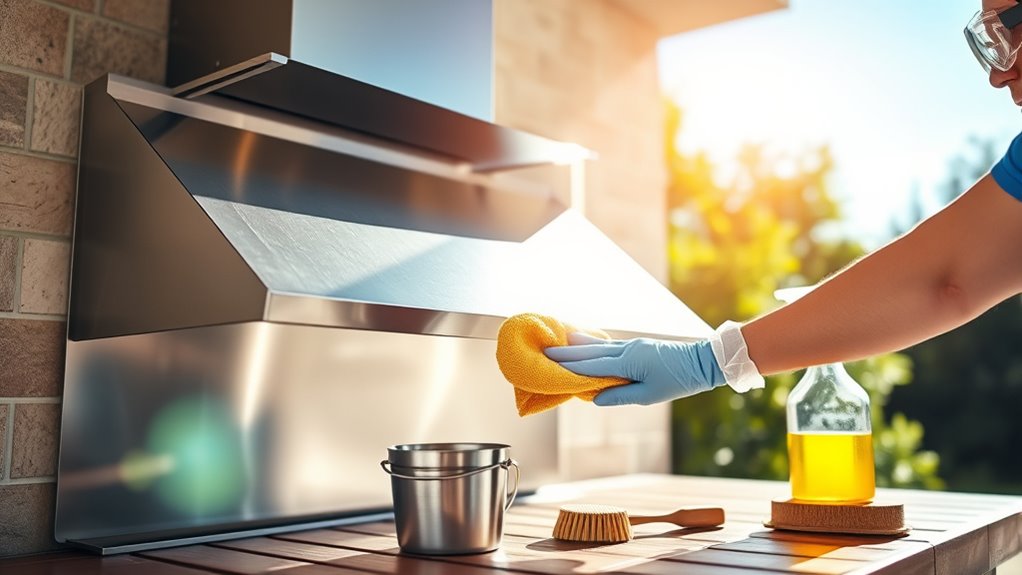
Regular cleaning and maintenance are essential to keep your outdoor vent hood functioning effectively. Regularly check and replace the filter to prevent buildup that can reduce airflow and trap odors. A clean filter guarantees peak performance and extends the life of your system. Pay attention to fan noise; if it becomes louder or irregular, it might indicate debris or a mechanical issue needing attention. Clean the fan blades and housing periodically to minimize noise and maintain efficiency. Remove any debris or grease buildup from the vent cover and surrounding areas. Consistent maintenance not only improves airflow and safety but also helps prevent costly repairs down the line. Staying proactive with these simple tasks ensures your vent hood operates smoothly and safely for years to come. Additionally, understanding the horsepower of your equipment can help ensure it’s operating at optimal performance levels.
Correct Installation and Placement Tips

To guarantee your vent hood works effectively, you need to install it at the proper mounting height—usually 24 to 30 inches above your cooktop. Make sure there’s enough clearance so smoke and fumes are captured promptly. Also, verify that your kitchen has adequate ventilation to support the hood’s performance. Proper installation can help prevent issues related to data privacy challenges, ensuring your kitchen remains safe and well-ventilated.
Proper Mounting Height
Proper mounting height is essential for your vent hood to operate effectively and safely. Correct mounting height ensures ideal vent alignment, which helps capture smoke, grease, and odors efficiently. If the vent is mounted too high, it won’t effectively remove fumes, reducing its safety and performance. Conversely, mounting it too low can interfere with cooking and cause a buildup of grease and debris. Check your manufacturer’s guidelines for the recommended mounting height, typically between 24 to 30 inches above the cooking surface. Use a level to ensure proper vent alignment during installation. Precise placement guarantees the hood functions as intended, providing safe and efficient outdoor ventilation. Taking the time to get the mounting height right now prevents problems later and keeps your outdoor cooking space safe and clean. Understanding proper installation techniques can also improve overall safety and effectiveness of your vent hood.
Ensure Adequate Ventilation
Are you confident your vent hood is providing enough airflow to keep your cooking area safe? Proper placement and installation are key to airflow maximization, ensuring your vent hood works at peak exhaust efficiency. Position the hood at the right height—typically 24 to 30 inches above the cooktop—to maximize airflow and capture fumes effectively. Make sure the vent duct is as short and straight as possible, avoiding bends that hinder airflow. Use a properly sized duct to prevent airflow restrictions. Confirm the vent is securely mounted and sealed to prevent leaks. Regularly clean filters and inspect the ductwork to maintain ideal performance. When installed correctly, your vent hood will efficiently remove smoke, odors, and heat, keeping your outdoor cooking space safe and comfortable. Additionally, choosing a vent hood with a high contrast ratio can improve visibility and safety during operation.
Recognizing and Addressing Common Issues

Sometimes vent hoods can develop issues that compromise their effectiveness, making it important to recognize and address them promptly. One common problem is poor airflow caused by blockages or debris buildup, which can be worsened if chimney flashing around the vent isn’t sealed properly, allowing moisture to cause rust or damage. Additionally, outdoor lighting near the vent can interfere with proper operation if it’s not positioned correctly, creating heat or glare that affects performance. Check for rust, loose connections, or corrosion regularly. Ensure the chimney flashing is intact and sealed to prevent leaks. Also, verify that outdoor lighting isn’t obstructing airflow or causing heat buildup. Addressing these issues quickly keeps your vent hood working efficiently and helps maintain outdoor safety. For those involved in outdoor safety, staying vigilant about environmental factors can prevent potential hazards.
Safety Precautions During Cooking and Maintenance
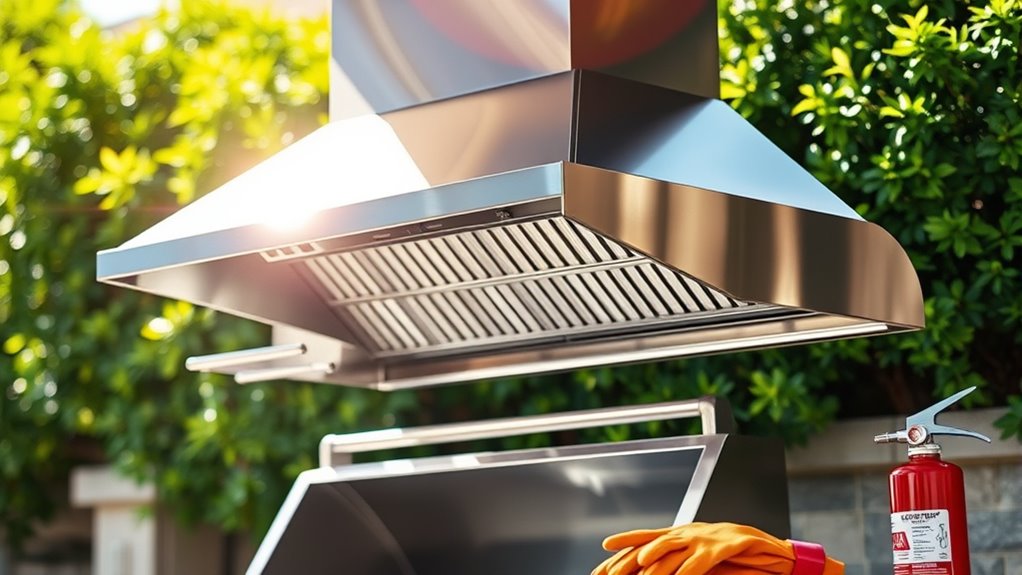
To stay safe while using your vent hood, make sure you’re using it properly and not blocking the vents. During maintenance, turn off the power and handle parts carefully to avoid accidents. Always keep fire safety in mind by keeping flammable items away and knowing how to respond if a fire starts. Regularly cleaning the vent filters can help prevent grease buildup and reduce fire risks.
Proper Vent Hood Use
When using your vent hood, safety should always come first to prevent accidents and guarantee effective ventilation. Many people believe vent hoods are unnecessary or that outdoor cooking safety negates the need for proper use, but this is a vent hood myth. Always verify your vent hood is correctly installed and functioning before cooking. Keep the area clear of flammable objects and never leave cooking unattended. Use the vent hood at the right speed to efficiently remove smoke and fumes. Regularly check that filters are clean and in good condition. Proper vent hood use not only enhances safety but also improves your outdoor cooking experience. Incorporating proper safety measures can further prevent hazards and ensure a secure outdoor cooking environment. Avoid shortcuts—following correct procedures safeguards everyone and keeps your outdoor space safe and enjoyable.
Safe Maintenance Practices
Maintaining your vent hood safely requires paying close attention during both cooking and maintenance tasks. Always turn off the power before performing any maintenance to guarantee electrical safety. When replacing filters, handle them carefully to avoid damaging the unit or causing injury. Regular filter replacement keeps your vent working efficiently and reduces fire risk. Use the table below to guide your maintenance routine:
| Task | Precautions |
|---|---|
| Filter Replacement | Turn off power, wear gloves |
| Cleaning Components | Use appropriate cleaners, avoid water contact with electrical parts |
| Checking Wiring | Ensure power is off, inspect for damage |
| General Maintenance | Follow manufacturer instructions |
Additionally, being aware of angel number meanings can provide spiritual guidance and reassurance during maintenance or when noticing recurring numbers that may signal upcoming changes in your home environment.
Fire Safety Measures
Since fires can start quickly if safety measures are ignored, it’s essential to stay vigilant during both cooking and maintenance. Always keep a fire extinguisher nearby and know how to use it in case of an emergency. Regularly check that your smoke alarms are working properly; they provide critical early warnings if smoke or fire occur. Never leave cooking unattended, and avoid wearing loose clothing that can catch fire. Keep flammable materials away from heat sources, and clean grease buildup regularly to prevent flare-ups. During maintenance, turn off the power supply and guarantee all flames are extinguished before working on the vent hood. Additionally, understanding fire safety precautions can significantly reduce risks during outdoor cooking and maintenance. Staying alert and prepared helps minimize fire risks and keeps you and your outdoor space safe.
Quick Troubleshooting and When to Call Professionals
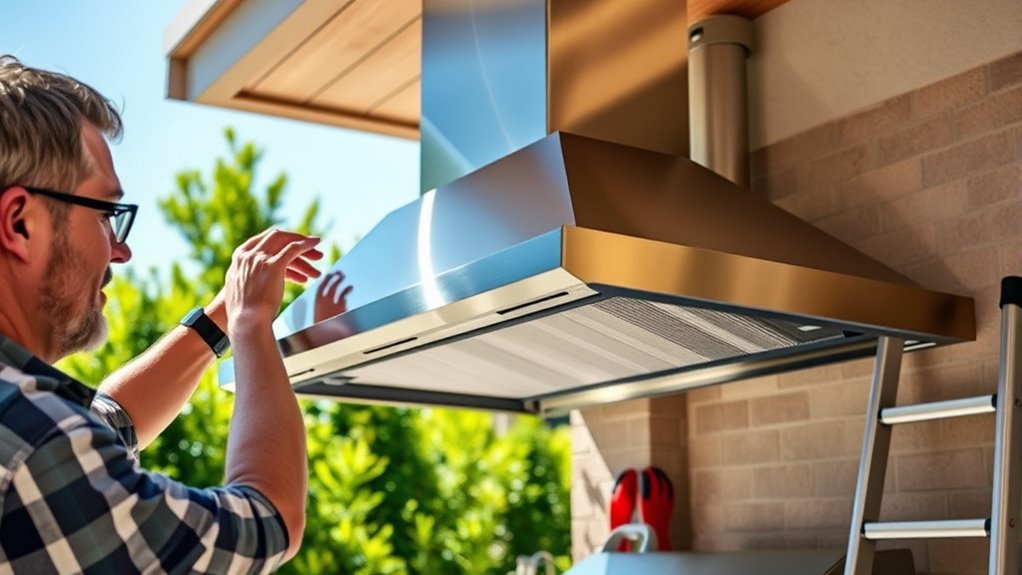
While many minor vent hood issues can be resolved quickly, recognizing when to call in a professional saves you time and prevents potential damage. If you notice persistent smoke or strange odors, check your smoke detector and fire alarm systems first—they can alert you to dangerous malfunctions. If the vent hood isn’t venting properly despite basic cleaning, or if you hear unusual noises, it’s time to call an expert. Don’t ignore flickering or malfunctioning smoke detectors, as they could signal electrical issues that require professional inspection. Attempting repairs beyond basic troubleshooting can cause further harm or void warranties. When in doubt, especially if safety alarms are involved, consulting a licensed technician ensures the problem gets fixed correctly and safely.
Frequently Asked Questions
How Often Should I Replace the Vent Hood Filter?
You should replace your vent hood filter every 6 to 12 months, depending on your filter maintenance routine and usage. Regularly check for grease buildup and debris, which can hinder airflow and reduce efficiency. If you notice excessive dirt or odors, it’s time for a replacement. Following a consistent replacement schedule guarantees your vent operates safely and effectively, preventing potential fire hazards and maintaining good indoor air quality.
Can I Install a Vent Hood Myself or Hire a Professional?
You can totally tackle DIY installation if you’re handy enough—just imagine transforming your kitchen into a chef’s paradise without waiting for a professional! But, if your tools are more for assembling IKEA furniture than handling tricky vents, professional assistance might save you from a ventilation disaster. Assess your skills honestly; sometimes, hiring a pro guarantees safety and efficiency, letting you enjoy your upgraded vent hood without any headaches or hazardous fumes.
What Are the Signs of a Blocked or Malfunctioning Vent Hood?
You’ll notice vent hood warning signs like poor airflow, lingering smoke, or excessive heat around the hood. Airflow obstruction indicators include reduced suction, strange noises, or a burning smell. If you see these signs, it’s time to verify for blockages or malfunctions. Regular maintenance helps prevent issues, but if problems persist, consider consulting a professional to ensure your vent hood operates safely and efficiently.
Is It Safe to Use a Vent Hood During a Power Outage?
During a power outage, it’s generally unsafe to use a vent hood, especially if it relies on electricity for operation. Power outage safety involves avoiding appliances that need power, including vent hoods with electric fans or lights. To guarantee safety, you should turn off the vent hood and avoid using it until power is restored. Always prioritize safety by understanding vent hood operation during power disruptions to prevent accidents.
How Can I Improve Airflow Efficiency Outdoors?
To improve outdoor airflow efficiency, you should maximize your ventilation techniques by positioning vents where prevailing winds can assist airflow. Keep vents clear of obstructions like plants or debris, and consider installing adjustable vents to control airflow direction and speed. Ensuring proper placement and maintenance enhances outdoor airflow, providing better ventilation and reducing stagnant air. Regularly check and clean vents to maintain ideal outdoor airflow and maximize ventilation effectiveness.
Conclusion
By mastering your outdoor vent hood basics, you guarantee a safer and more efficient cooking space. Regular cleaning, proper installation, and quick troubleshooting keep issues at bay. Remember, a stitch in time saves nine—address problems early before they escalate. Stay vigilant, follow safety tips, and don’t hesitate to call professionals when needed. With these quick wins, you’ll keep your outdoor cooking area running smoothly and safely, turning every meal into a worry-free celebration.
